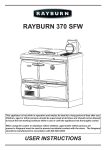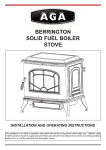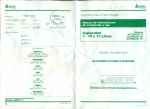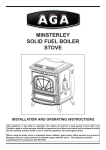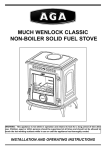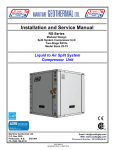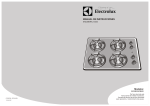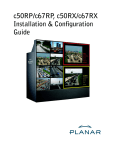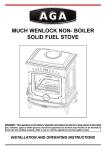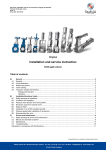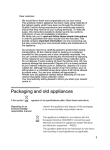Download AGA LITTLE WENLOCK Technical data
Transcript
LITTLE WENLOCK GAS STOVE This appliance is hot while in operation and retains its heat for a long period of time after use. Children, aged or infirm persons should be supervised at all times and should not be allowed to touch the hot work- ing surfaces while in use or until the appliance has thoroughly cooled. INSTALLATION AND OPERATION INSTRUCTIONS To ensure safety, satisfaction and reliable service this stove should be installed by a suitably qualified and competent person. TABLE OF CONTENTS PAGE NO. 1. Operation Instructions . . . . . . . . . . . . . . . . . . . . . . . . . . . . . . . . . . . . . . . . . . . . . . . . . . . 2 2. Precautions . . . . . . . . . . . . . . . . . . . . . . . . . . . . . . . . . . . . . . . . . . . . . . . . . . . . . . . . . . . 2 3. Lighting . . . . . . . . . . . . . . . . . . . . . . . . . . . . . . . . . . . . . . . . . . . . . . . . . . . . . . . . . . . . . . 2 4. What to do if you smell gas 5. Vent Safety Shut Off Switch . . . . . . . . . . . . . . . . . . . . . . . . . . . . . . . . . . . . . . . . . . . . . . 3 6. Technical Data 7. General . . . . . . . . . . . . . . . . . . . . . . . . . . . . . . . . . . . . . . . . . . . . . . . . . . . . . . . . . . . . . . 4 8. Pre-Installation Assembly . . . . . . . . . . . . . . . . . . . . . . . . . . . . . . . . . . . . . . . . . . . . . . . . 5 9. Location. . . . . . . . . . . . . . . . . . . . . . . . . . . . . . . . . . . . . . . . . . . . . . . . . . . . . . . . . . . . . . 5 10. Minimum Clearances to Combustible Materials . . . . . . . . . . . . . . . . . . . . . . . . . . . . . . . 5 11. Hearth Fitting. . . . . . . . . . . . . . . . . . . . . . . . . . . . . . . . . . . . . . . . . . . . . . . . . . . . . . . . . . 6 12. Dimensions . . . . . . . . . . . . . . . . . . . . . . . . . . . . . . . . . . . . . . . . . . . . . . . . . . . . . . . . . . . 7 13. Chimney’s/Flues . . . . . . . . . . . . . . . . . . . . . . . . . . . . . . . . . . . . . . . . . . . . . . . . . . . . . . . 7 14. Suitable Materials . . . . . . . . . . . . . . . . . . . . . . . . . . . . . . . . . . . . . . . . . . . . . . . . . . . . . . 7 15. Use of Existing Chimney’s and Flues . . . . . . . . . . . . . . . . . . . . . . . . . . . . . . . . . . . . . . . 8 16. Factory-Made Insulated Chimneys . . . . . . . . . . . . . . . . . . . . . . . . . . . . . . . . . . . . . . . . . 9 17. Ventilation & Combustion Air Requirements . . . . . . . . . . . . . . . . . . . . . . . . . . . . . . . . . . 9 18. Gas Pipes & Fittings . . . . . . . . . . . . . . . . . . . . . . . . . . . . . . . . . . . . . . . . . . . . . . . . . . . . 9 19. Meters . . . . . . . . . . . . . . . . . . . . . . . . . . . . . . . . . . . . . . . . . . . . . . . . . . . . . . . . . . . . . . . 9 20. Gas Pipe Size . . . . . . . . . . . . . . . . . . . . . . . . . . . . . . . . . . . . . . . . . . . . . . . . . . . . . . . . . 9 21. Connection to Gas Supply . . . . . . . . . . . . . . . . . . . . . . . . . . . . . . . . . . . . . . . . . . . . . . . 9 22. Gas Soundness Testing . . . . . . . . . . . . . . . . . . . . . . . . . . . . . . . . . . . . . . . . . . . . . . . . . 10 23. Placement of Coals . . . . . . . . . . . . . . . . . . . . . . . . . . . . . . . . . . . . . . . . . . . . . . . . . . . . 10 24. Lighting . . . . . . . . . . . . . . . . . . . . . . . . . . . . . . . . . . . . . . . . . . . . . . . . . . . . . . . . . . . . . . 11 25. Burner Lighting . . . . . . . . . . . . . . . . . . . . . . . . . . . . . . . . . . . . . . . . . . . . . . . . . . . . . . . . 12 26. Spillage Test . . . . . . . . . . . . . . . . . . . . . . . . . . . . . . . . . . . . . . . . . . . . . . . . . . . . . . . . . . 12 27 Pilot Flame . . . . . . . . . . . . . . . . . . . . . . . . . . . . . . . . . . . . . . . . . . . . . . . . . . . . . . . . . . . 12 28. Maintenance. . . . . . . . . . . . . . . . . . . . . . . . . . . . . . . . . . . . . . . . . . . . . . . . . . . . . . . . . . 12 . . . . . . . . . . . . . . . . . . . . . . . . . . . . . . . . . . . . . . . . . . . . . . 3 . . . . . . . . . . . . . . . . . . . . . . . . . . . . . . . . . . . . . . . . . . . . . . . . . . . . . . . . 4 Removal of Burner . . . . . . . . . . . . . . . . . . . . . . . . . . . . . . . . . . . . . . . . . . . . . . . . 12 Changing of Burner Injector Orifice. . . . . . . . . . . . . . . . . . . . . . . . . . . . . . . . . . . . 13 Removal of Pilot Burner . . . . . . . . . . . . . . . . . . . . . . . . . . . . . . . . . . . . . . . . . . . . 13 29. Enamel Cleaning . . . . . . . . . . . . . . . . . . . . . . . . . . . . . . . . . . . . . . . . . . . . . . . . . . . . . . 13 30. Exploded View . . . . . . . . . . . . . . . . . . . . . . . . . . . . . . . . . . . . . . . . . . . . . . . . . . . . . . . . 14 31. Trouble Shooting Guide . . . . . . . . . . . . . . . . . . . . . . . . . . . . . . . . . . . . . . . . . . . . . . . . . 15 1 OPERATION INSTRUCTIONS WARNING: Fig. 1 Do not operate the stove with the appliance door open, or if the glass panel in the front door has been broken or removed. that the door latch is fully locked. Ensure Keep the door spin valve closed at all times when stove is in operation. PRECAUTIONS 1. Do not touch any part of the stove while in 2. Children and adults should be alerted to the 3. operation, except the controls. 3. hazzards of surface temperatures. Guards may be required to take account of the special hazzards that exist in nurseries 4. and other places where there are young 4. 5. children, aged or infirm persons. Curtains or other combustible material should 5. not be positioned on/or above the appliance at a distance less than 38” (965mm). Press the control knob all the way in and turn anti-clockwise until you hear a clicking sound. Keep the control knob pressed for 15-30 seconds, and then release . If the pilot fails to remain lighting repeat this action. With the pilot burner lighting, to establish the flame hold the control knob in the fully pressed position with dot pointing towards Do not use this appliance if any part has been ignition. under water, immediately call a qualified ser- vice technician to inspect the appliance and to (see Fig.2) Fig. 2 replace any part of the gas control or system 6. 7. 8. 9. which has been under water. Do not store gasoline or other flammable liquids having flammable vapours near this stove. Tools must not be used to turn or operate the valve control knob. Use only in a sufficiently ventilated space. This appliance must be installed in accordance with the rules in force. 10. Read the label and manual provided before 6. commencing to install or attempting to operate the stove. To light the main burner, fully release the control knob and turn anti-clock-wise to the required setting. FAILURE TO DO SO MAY RESULT IN (see Figs. 3&4) Fig. 3 PROPERTY DAMAGE OR PERSONAL INJURY. LIGHTING 1. The stove control knob is located at the 2. The valve is in the off position when the bottom righthand side looking from the front. control knob symbol “OFF” is at the datum point and there is no gas to the pilot or burner. main The knob can only be turned in a clockwise direction to reach the “OFF” High Flame Setting position. (see Fig.1) 2 Fig.4 WHAT TO DO IF YOU SMELL GAS Low Flame Setting 7. A. Turn off the gas mains. B. Do not try to light any appliance. C. Do not touch any electrical switch. D. Open windows. E. Do not use any phone in the building. F. Immediately call your gas engineer from a G. If you cannot reach your gas supplier, call the To turn off the main burner, turn the control knob in a clockwise direction to low flame. (see Fig. 4) Fig. 5 neighbours phone. Fire Department. VENT SAFETY SHUT OFF SWITCH The vent safety shut off switch location is designed to shut down the stove when exposed to excessive temperatures due to severe down draughts, blocked flues or negative pressure due to a fresh air shortage. It must not be disconnect- ed or isolated in any way. WARNING: 8. While pressing the control knob to be isolated or adjusted. Parts to be replaced with identical and/or equiva- continue lent original parts. to turn in a clockwise direction until it stops. The stove is now off. (see Figs. 5&6) What to do if the vent safety shut off switch continually goes off: Fig. 6 NOTE: During the first light-up period an odour will arise from the stove, this is due to the materials in the stove drying and curing. Not It is advisable to open a door or window to give extra ventilation to the room until the odour has gone. 3 A: Wait for 4 minutes after shut down. B: Refer to these lighting instructions for C: If stove fails to light repeat the above D: If stove fails to light after three attempts lighting procedures. procedures. contact your local Aga Dealer. TECHNICAL DATA GENERAL Pressure Setting From Cold Natural Gas Inlet Pressure = Product Identification No.: viduals I2E, G20, 20 mbar/8” wg & The = 7.4”/18.5 mbar imperative Maximum flow rate Minimum flow rate Burner: = system should be More that control circulating air compartments, passageways of It is burners the room It this manual. NOTE: 3 37.78 MJ/m Before installation, check that the local distribution 3 0.505 m /hr conditions, nature of gas and pres- sure, and adjustment of the appliance are com- 3 0.143 m /hr patible. CPD Gas Burner When installing, operating and maintaining your Burner Injectors: Little wenlock Gas Stove, respect basic standards CAT 18 Bray 320 - N.G. of safety. Read these instructions carefully before commencing installation or attempting to operate Pilot Injectors your stove. Size 3.5 - N.G. Ignition: flue publications may be superseded during the life of C, 1,013mbar in relation to = and should be noted that the requirements and these = Class 2 = may The complete installation must be done in accor- gross calorific value of gas. Calorific Value and dance with current Standards and Local Codes. o Gas Flow Rates at 15 heater heater are kept clean. = 1.5kW/5,118 Btu’s/h Efficiency: warranty sive lint from carpeting, matting material, etc. = 5.3kW/18,084 Btu’s/h Min. Input Natural Gas Natural Gas gross room and Max. Input Natural Gas product frequent cleaning may be required due to exces- 1.1”/2.7 mbar Gross Input the inspected before use and at least annually. Manifold Pressure Minimum Setting Natural Gas void Thank you for buying a Little Wenlock Gas Stove. Manifold Pressure Maximum Setting = will result in property damage or injury. I2H, G20, 20 mbar/8” wg (I.E. & G.B.) Natural Gas repair Any adjustments undertaken by unqualified indi- I.E., G.B., F.R.& B.E Gas Type: commissioning, qualified service technician and installer. BIIBS Country of Designation: Installation, and maintenance should only be undertaken by a 0063 AS 5164 Appliance Category N.G.: WARNING: 8”/20mbar Failure to do so may result in damage to property or personal injury and may void the Piezo Igniter product warranty. It is important to note that once a type of gas has been specified the stove cannot run off any other L.P.G.) Stove Weight: 138lbs / 62.5 kilos The type burner of units gas. are (i.e. not Natural Gas interchangeable between Natural Gas or L.P.G. 0063 U.K. Installation Install in accordance with the: * * The Gas Safety (Installation and Use) Regulations 1998 (as amended). BS 5440: Parts 1 & 2, Installation & maintenance of flues and ventilation for gas appliances of rated input not exceeding 70 kW (1st, 2nd & 3rd family * gases). B.S. 5871: Parts 1, 2 & 3, Specification for installation of gas fires, convector heaters, fire/back boiler and decorative * 4 or fuel effect gas appliances. Building Regulations for Britain, Scotland, Wales and Northern Ireland. This appliance has been tested and approved Fig.9 in accordance with the essential requirements of Annex 1 in the Gas Appliance (90/396/EEC) as amended. Directive PRE- INSTALLATION ASSEMBLY Before installing the appliance carry out the following pre-installation assembly: Fig.7 3. Ensure the leads to the vent safety shut off switch located on the back of the stove are connected and secure. (See Fig. 10). Fig.10 1. Open the fire door (item 9), and remove 2. This stove may be connected to either a the package of ceramic coals. (See Fig.7) top or rear flue outlet. The stove has a rear flue outlet configuration factory fitted. It may be changed to a top flue outlet by simply switching the blanking cap and flue collar as shown in Fig. 8 & 9. Fig.8 4. Position stove in its chosen location and connect to the chimney/flue system. LOCATION There are many conditions to be considered when selecting the location for you Little wenlock Gas Stove. MINIMUM CLEARANCES TO COMBUSTIBLE MATERIALS (see Figs 11, 12, 13, 14) CAUTION: Allow adequate clearances for stove operation and annual servicing removal and injector removal. Back wall burner 6” (150mm) Left side wall looking from front 5” (125mm) Alcove or mantle from top of unit 18” (459mm) Right side wall looking from front From Corner 5 e.g. 5” (125mm) 5” (125mm) Fig.14 Fig.11 When installing the stove against a combustible wall leave a 6” space Fig.12 Fig.15 between the back of the stove and When installing the stove against a the wall for air circulation. non-combustible wall leave a 2” space (See Fig.12) between the back of the stove and the wall for air circulation. (See Fig.15) HEARTH FITTING Fig.13 This stove MUST be installed on a concrete con- structional hearth, or on a non-combustible hearth slab, minimum size 27.5” (500mm) x 28.8” (732mm) deep with the fire place opening centrally located. 13mm ( 50mm 1 /2”) (2”) The hearth material should be at least thick, the top surface being preferably above floor level to discourage placing of carpets over it. (see Fig.16) 6 the Fig.16 Fig.17 The chimney and flue pipes intended for use with this appliance should be mechanically robust, resistant to internal and external corrosion, non- combustible, and durable under the conditions to which they are likely to be subjected. WARNING: nected to a lation Only operate this appliance if conproperly chimney system. installed and of flues for gas appliances The instal- should accordance with the following standard: maintained Do not tamper with the vent * safety shut-off system. be in BS 5440 Installation & maintenance of flues and ventilation for gas appliances of rated input not exceeding 70kW (1st, 2nd & 3rd DIMENSIONS family gases). Part 1: - Specification for installation of Part 2: - Specification for installation & flues. maintenance of ventilation of gas appliances. * B.S. 5871: Parts 1, 2 & 3, specification for installation of gas fires, convector heaters, fire/back boiler and decorative fuel effect gas appliances. SUITABLE MATERIALS A B C D E F Metric (mm) 405 540 430 445 96 335 16 21 2 /8 7 /8 16 17 4 /8 6 /8 3 Mineral Fibre cement pipes conforming to * Sheet metal conforming to B.S. 715. * Dimensions Imperial (inches) * 2 /8 13 the stove outlet. (see fig.17) the chimney or flue serving B.S. 4543 (a galvanised finish is not suitable). Clay flue linings conforming to I.S. 51 & * Pre-cast concrete chimney blocks, incorporat- * zontal run should not exceed 300mm (12”) from of Insulated metal chimney’s conforming to B.S. EN 1457 1999. ed into the building structure. It is particularly important that the correct connection block be If connecting to a rear exit configuration the hori- height 567. * CHIMNEY’S / FLUES The B.S. this provided at the base of the flue, B.S. 1289. Cast iron or acid resistant vitreous enamelled lined mild steel to B.S. 41. Where appliance should not be less than 3 meters (10’), twin struction and not more than 11 meters (36’), measured ver- wall the pipes length of are of pipe sheet located metal con- externally should not exceed 1m (3’3”) unless it is readily tically from the outlet to the top of the flue terminal accessible for renewal. and having a diameter of 125mm (5”). Note: Never connect to a chimney or flue system serving another appliance. 7 USE OF EXISTING CHIMNEYS AND FLUES Fig.19 (See Figs. 18, 19 & 20) An existing flue pipe or chimney that has proved to be satisfactory when used for solid fuel can normally be used for a gas appliance provided that its construction and condition is acceptable. Flues that have proved to be unsatisfactory, particularly with regard to down draught, should not be used for venting gas appliances until they have been examined and any faults corrected. If there is any doubt regarding an existing chimney a smoke test to B.S. 5440: Part 1 should be carried out. Before connecting this appliance to a chimney or flue pipe another which fuel, has the thoroughly swept. previously chimney or been flue used pipe with must be All register plates, restrictor plates, dampers etc. which could obstruct the flue at a future date should be removed before connecting this appliance. Note: A flue spigot extension of up to a maximum total length of 300mm (12”) may be fitted if neces- sary, provided a minimum clearance of 50mm (2”) between its open end and the nearest obstruction is always provided. Note: Fig.20 It may be necessary to reline the flue in order to help avoid spillage. (see Figs. 19 & 20). Fig.18 8 * FACTORY-MADE INSULATED CHIMNEY’S * Factory-made insulated chimneys must be con- * structed and tested to meet the relevant standards and recommendations given in: * B.S. 7566: * * Installation of factory made * chimney’s conforming to B.S. : 4543 for * domestic appliances. Part 1: Method of specifying installation Part 2: Specification for installation design. Part 4: Recommendation for installation B.S. 4089 - L.P.G. hoses and assemblies. If using an existing meter have it checked to ensure that the meter is capable of dealing with the total rate of gas needed. GAS PIPE SIZE This stove has a heat input of less than 7 kW and therefore does not normally require any additional It is important that the correct service pipe size be However, consideration must be given used for adequate gas supply. to the local rules in force. This depends on the distance between the supply meter and the appliance relative to the input requirements. Any air vent must either be connected The gas supply to the appliance should be terminated direct to an outside air supply or to adjacent near the appliance with an approved safety type rooms having a permanent vent to the out service tap. side. If there is another combustion appliance CONNECTION TO GAS SUPPLY fitted in the same or adjacent room, it will be necessary to refer to the rules in force to * B.S. 6362 - stainless steel tubes. B.S. 1740 - Wrought steel pipes. board or by an appointed contractor. MENTS * B.S. 1387 - Steel tubes. service pipe either by a representative of the gas VENTILATION & COMBUSTION AIR REQUIRE- * equipment. A suitable gas meter must be connected to the Specification for site installation. design and installation. ventilation. B.S. 759 - valves, gauges and other safety METERS design information. Part 3: EN 29453 & I.S.O. 9453 - Soft Solders. B.S. 669 - flexible hoses, fittings & sockets. The gas control is located at the bottom right hand calculate the additional air supply. side of the unit. If there is an air extraction fan fitted in the Check that the mains gas supply pipe is adequately sized and capable of supplying room or adjacent rooms where this appliance enough gas to the appliance when operating on is fitted, additional air vents may be required max. rate. to alleviate the possibility of spillage of products of combustion from the appliance/flue while the fan is in operation. Refer to the rules * WARNING: in force. Where such an installation exists, a test for as this will cause blockage within the stove con- spillage should be made with the fan or fans trol, pilot burner, injectors and pipework. and other gas burning appliances in operation * to do so may void product warranty. at full rate. If spillage occurs following the above oper- Fig.21 ation, an additional air vent of sufficient size to prevent this occurrence should be installed. GAS PIPES & FITTINGS Materials used for installation work should be fire resistant and gas tight and should conform to the following or their equivalent. * I.S. 238, I.S. 239 and prEN 1057 - Copper * I.S. 265 - Installation of gas service pipes. * Before connecting the stove make sure the gas supply pipe is clear of grit and debris tubes. I.S. 266 - Polyethylene pipes. 9 Failure WARNING: To avoid pipe sealing PLACEMENT OF COALS compounds from entering into the gas train, do not apply seal- WARNING: ing compound to the first two threads at the tip of stove the gas connection. are The ceramic coals supplied with this extremely durable and long lasting when fitted properly. They are, however, very del- icate and can be easily damaged if they are not Fig.22 handled very carefully. Handling damage to the ceramic coals is not covered by warranty. 1. Before positioning the coals in the combustion chamber, check for dust particles and grime, vacuum if necessary. Position the coals as per instructions as incorrect placement will effect the performance of the stove. Fig.23 Dust off the inside of the door glass using a clean dry cloth. Note: (see Fig.24) Exhibit care when cleaning the burner to avoid blockage or damage of burner parts. Fig.24 NOTE: Clean off any excess pipe compounds from connections. WARNING: Only connect to gas type indicated on the rating plate. GAS SOUNDNESS TESTING Gas soundness testing should be in accordance with I.S. 813 (I.E.) and B.S. 6891 (U.K.). 2. Correct gas pressure and proper gas supply pipe sizing is important for the successful performance of this appliance. Make sure that the plumber or 3. gas supplier checks the gas supply line and gas pres- gas supply during any gas soundness testing at pressures in excess of 50 mbar. After testing gas supply pipe work, open isolation valve to stove and carry out gas soundness testing at normal working pressure of 20 mbar. With stove lighting carry out a leak test down- stream of control using gas leak detection fluid. CAUTION: with the holes in the gasket. Lay the ceramic matrix on the burner with the holes in the burner lined up with the holes Fig.25 The appliance must be isolated from system burner with the holes in the burner lined up in the ceramic. (see Fig. 25) sure at installation. CAUTION: Lay the gasket material provided, on the If using a gas leak detection fluid for leak testing DO NOT spray solution onto control body. 10 4. 5. Place 4 medium coals on the front of the Lay the two remaining medium coals random- one corner of each coal resting on a spar. one corner of the coals touch any other coal. matrix with their corners touching and also ly on the matrix ensuring that no more than (see Fig.26) (See Fig. 29) Fig.26 Fig.29 Place 4 large coals on the rear of the matrix with their corners touching. The front corner should over hang the back section of the matrix by approximately 10mm. (See Fig.27) IMPORTANT: Fig.27 Leave an air space around each coal to allow easy flow of products of combustion, too much impingement cause sooting. 10mm of flame on coals will LIGHTING First Lighting- Purge air from the supply line as follows: a. Open main shut-off valve. pressure test point. Unscrew inlet Leave open inlet test screw until gas comes. b. 6. ately. WARNING: Place 3 small coals on 3 of the medium purge the system near control knob pressed for 15-30 seconds. control knob. action. Fig.30 Place a medium coal on the medium coal which does not already have a small coal Ensure one corner of the medium coal rests against the large coal behind it. 11 a Turn anti- clockwise until you hear a clicking sound. Fig.28 on top of it. not Press in the control knob all the way. Place the last small coal on either side of the matrix. (See Fig.28) 7. Do naked flame or hot surface. coals leaving one corner of the small coal touch the large coals. When gas comes tighten inlet screw immedi- Keep Release If the pilot fails to light repeat this WARNING: Do not operate the stove with the Fig.31 appliance door open, or if the glass panel in the CORRECT FLAME INCORRECT FLAME front door has been broken or removed. Ensure the door latch is fully locked. Keep the door spin valve closed at all times when the stove is in operation. During the first light up period an odour will rise from the stove, this is due to the materials in the stove drying and curing. window or door to give It is advisable to open a extra room until the odour has gone. ventilation to the IMPORTANT: tor will result in a reduced flame which may be 1. With the pilot flame firmly established turn the insufficient for ignition purposes. control knob anti-clockwise to the high position. When the main burner is lighting adjust con- MAINTENANCE trol knob clockwise to a lower setting if required. CAUTION: Maintenance of this stove should only 2. If the pilot light is extinguished either inten- be tionally or unintentionally no attempt should be carried Engineer. made to light the gas until at least 4 mins. have out by a qualified/competent Gas Isolate the main gas supply before carrying elapsed. out any maintenance. SPILLAGE TEST NOTE: Please ensure that the pilot injec- tor is clear at all times, as a partially blocked injec- BURNER LIGHTING Removal of Burner It is essential that every flue system be 1. Shut off gas supply at the shut off valve. inspected and tested by the installer upon com- 2. Open door (item 9). pletion, to ensure that the combustion products 3. Carefully remove the coals. are completely discharged to the outside atmos- 4. Disconnect the 8mm gas pipe at the back phere. of the control under the lip. When the stove is installed carry out a spillage (see Fig.32) Fig.32 test (See Fig.30) as outlined in the following procedure: a. Operate stove for a minimum of 10 mins. at maximum setting. b. Run all other combustion appliances and/or extraction fan/s fitted in the room or adjacent rooms at full setting e.g. clothes dryers, fur- c. naces etc. Close windows and external doors. d. With a smoke match, joss stock or smoke puffer run around 1” (25mm) from the edge of the down draught opening. (See Fig. 30). 5. Disconnect the snap switch leads from the e. If all the smoke is pulled into the down draught snap switch located at the back of the stove. opening, there is no spillage. (See Fig. 33). 6. Remove the two M6 wing nuts located on the under side of the stove on the right and on the PILOT FLAME NOTE: left. The pilot flame should be a steady blue with the left side and gradually turning the flame which has contact with the upper 3/8” of the thermopile. (See Fig.33). 7. Carefully lift up the burner assembly starting assembly anti-clockwise until the left side of the (See Fig 31) assembly is facing towards the door opening. (See Fig.35, 36, 37). 12 Fig.38 Fig.33 Fig.34 Changing of Burner Injector Orifice With the complete burner assembly removed as per Fig. 35, 36, 37. 1. Disconnect the 6mm gas feed pipe from the 2. Slacken the 6mm gas feed pipe to the 3. control to injector. (see Fig. 38). injector at the control. Remove Injector from burner. Removal of Pilot Burner 1. Fig.35 2. Unscrew the two pilot burner. 1 /4” slotted head screw from (See Fig.39) Disconnect the 6mm gas feed pipe. Fig.39 ENAMEL CLEANING Fig.36 General cleaning must be carried out when the stove is cool. If this stove is finished in a high gloss vitreous enamel, to keep the enamel in the best condition observe the following tips: 1. Wipe over daily with a soapy damp cloth, 2. For stubborn deposits a soap impregnated 3. Fig.37 followed by a polish with a clean dry duster. pad can be carefully used on the vitreous enamel. Use only products recommended by the Vitreous Enamel Association, these products carry the vitramel label. ASSOCIATION 4. DO NOT USE ABRASIVE PADS OR OVEN CLEANSERS CONTAINING CITRIC ACID ON ENAMELLED SURFACES. ENSURE THAT THE CLEANSER MANUFACTURERS INSTRUCTIONS ARE ADHERED TO. 13 LITTLE WENLOCK GAS EXPLODED VIEW 1. 2. 3. 4. 5. 34 6. 7. 8. 9. 10. 11. 12. 13. 14. 35 15. 16. 17. 18. 19. 39 36 20. 37 Leg 21. Front Frame 22. Blanking Plate 23. Flue Spigot Hob Back Casting Burner NG 26. Aga Stove Badge 28. 1/4” BSP Nut 29. Mains Inlet Bracket 30. Vent Switch Bracket 31. Rating Plate Bracket 32. Vent Switch 33. Coal Matrix 34. Door Assembly 35. Control Plate 36. Serial Number Plate 37. Data Plaque 38. Front Baffle 39. Back Baffle 38 Tie Rod (M8*260mm) Mains Inlet Pipe 27. Base Long Tie Bolt 24. 25. LH & RH Side Panels Door Catch Inlet Valve Dia. 8 x 6mm Olive Spin Valve Door Hinges Door Glass Door Handle Glass Clips Burner Gasket Thermocouple C/W Leads Pilot Injector Pilot Electrode Gas Valve Control Valve Knob 23 4 3 7 13 5 11 20 18 10 6 12 22 19 14 28 2 33 25 24 21 27 17 16 9 31 8 30 26 1 32 15 29 14 6 TROUBLE SHOOTING GUIDE PROBLEM POSSIBLE CAUSE SOLUTION Pilot will not light No gas Check gas is turned on. Safety interlock preventing Operation. Control knob not fully pressed. Ensure control knob is being fully Disconnected piezo igniter. Connect piezo cable. Insufficient gas pressure. Call your qualified service technician. Blocked orifice. Call your qualified service technician. Air in gas lines Damaged pilot hood. Defective control valve. Faulty piezo igniter Pilot lights but goes out when the control knob is released. Insufficient flame impingement on thermocouple. Incorrect position of thermocouple. Weak milli volt current. Poor electrical contacts. Burners will not light. Wait 5 minutes & attempt to relight. Control knob may not be pressed. Call your qualified service technician. Call your qualified service technician. Call your qualified service technician. Call your qualified service technician. Call your qualified service technician. Call your qualified service technician. Call your qualified service technician. Call your qualified service technician. Turn control knob anti-clockwise to a turned to correct position. heat output setting. Incorrect inlet pressure. Call your qualified service technician. Air in gas lines. Blocked orifice. Faulty control valve. Call your qualified service technician. Call your qualified service technician. Call your qualified service technician. Heater operates normally Blocked flue. Clear blockage. 10 minutes. switch activating. Call your qualified service technician. Noise in pilot/burners Excessive gas pressure. Call your qualified service technician. Draught hood spillage. Chimney or venting system not Increase height. then goes out within Insufficient draught leading to the Defective vent safety switch. high enough. Call your qualified service technician. Chimney or venting system blocked Clear blockage. Leaks in chimney or venting Seal joints. Insufficient air supply when other Call your qualified service technician. system joints. air using appliances are in operation. Flame characteristics: Hard sharp flame Yellow flame Lifting flame Small sharp flame Excessive primary air. Reduce air intake. Insufficient primary air supply. Increase air intake. Excessive gas pressure. Call your qualified service technician. Semi clogged gas supply line. Call your qualified service technician. Over sized burner orifice. Clogged burner orifice. Excessively low gas pressure. Call your qualified service technician. Call your qualified service technician. Call your qualified service technician. Aga, Station Road, Ketley, Telford, Shropshire, TF1 5AQ, UK 15 N00398AXX Rev:002 DP 060822
















